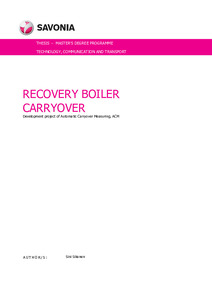Recovery boiler carryover
Sikanen, Sini (2022)
Sikanen, Sini
2022
All rights reserved. This publication is copyrighted. You may download, display and print it for Your own personal use. Commercial use is prohibited.
Julkaisun pysyvä osoite on
https://urn.fi/URN:NBN:fi:amk-2022121830748
https://urn.fi/URN:NBN:fi:amk-2022121830748
Tiivistelmä
The aim of the thesis was to study recovery boiler as a part of kraft pulp process and carryover in recovery boilers. Another aim was to follow the development process of new Automatic Carryover Measuring device, ACM.
Recovery boiler is the most important and expensive part of the pulp mill. Black liquor, which is side product from chemical wood refining process is the main fuel in recovery boiler combustion process. Black liquor contains 40-50% inorganic material, which makes its use challenging for steam and power generation. Upon combustion those inorganic materials form low melting temperature ash or smelt.
With flue gases, so called fly ash rises to the upper part of boiler and forms deposits.
There are three basic types of fly ash particles: Carryover, Fume and Intermediate size particles.
Carryover deposits are formed of molten or partially molten smelt particles and partially burned black liquor solids. Carryover deposits are more smelt-like, usually pink in color, fused and very hard when sticking into tube surface. Carryover causes fouling for the lower superheater areas.
Automatic Carryover Measurement, ACM will take carryover sample automatically from the flue gases and sample will be analyzed from the image of the sample. ACM controller analyzes the image by specific algorithm and measures a relative amount of sulfate, sulfide and unburned components from the flue gases. Sample based values can be used to control the combustion of the recovery boiler
The ACM development project was divided into the following phases: mechanical engineering, software engineering, cold test and finally hot test in a real mill environment. Project proceeded first well, engineering phase and cold tests were successful. At the beginning of the hot test, it was noticed that some modifications still needed to be done for the device. Hot test will be continued after modifications for the ACM device has been done. Overall, it seems like the device is working as it should, but hot test will show the final functionality.
Recovery boiler is the most important and expensive part of the pulp mill. Black liquor, which is side product from chemical wood refining process is the main fuel in recovery boiler combustion process. Black liquor contains 40-50% inorganic material, which makes its use challenging for steam and power generation. Upon combustion those inorganic materials form low melting temperature ash or smelt.
With flue gases, so called fly ash rises to the upper part of boiler and forms deposits.
There are three basic types of fly ash particles: Carryover, Fume and Intermediate size particles.
Carryover deposits are formed of molten or partially molten smelt particles and partially burned black liquor solids. Carryover deposits are more smelt-like, usually pink in color, fused and very hard when sticking into tube surface. Carryover causes fouling for the lower superheater areas.
Automatic Carryover Measurement, ACM will take carryover sample automatically from the flue gases and sample will be analyzed from the image of the sample. ACM controller analyzes the image by specific algorithm and measures a relative amount of sulfate, sulfide and unburned components from the flue gases. Sample based values can be used to control the combustion of the recovery boiler
The ACM development project was divided into the following phases: mechanical engineering, software engineering, cold test and finally hot test in a real mill environment. Project proceeded first well, engineering phase and cold tests were successful. At the beginning of the hot test, it was noticed that some modifications still needed to be done for the device. Hot test will be continued after modifications for the ACM device has been done. Overall, it seems like the device is working as it should, but hot test will show the final functionality.
